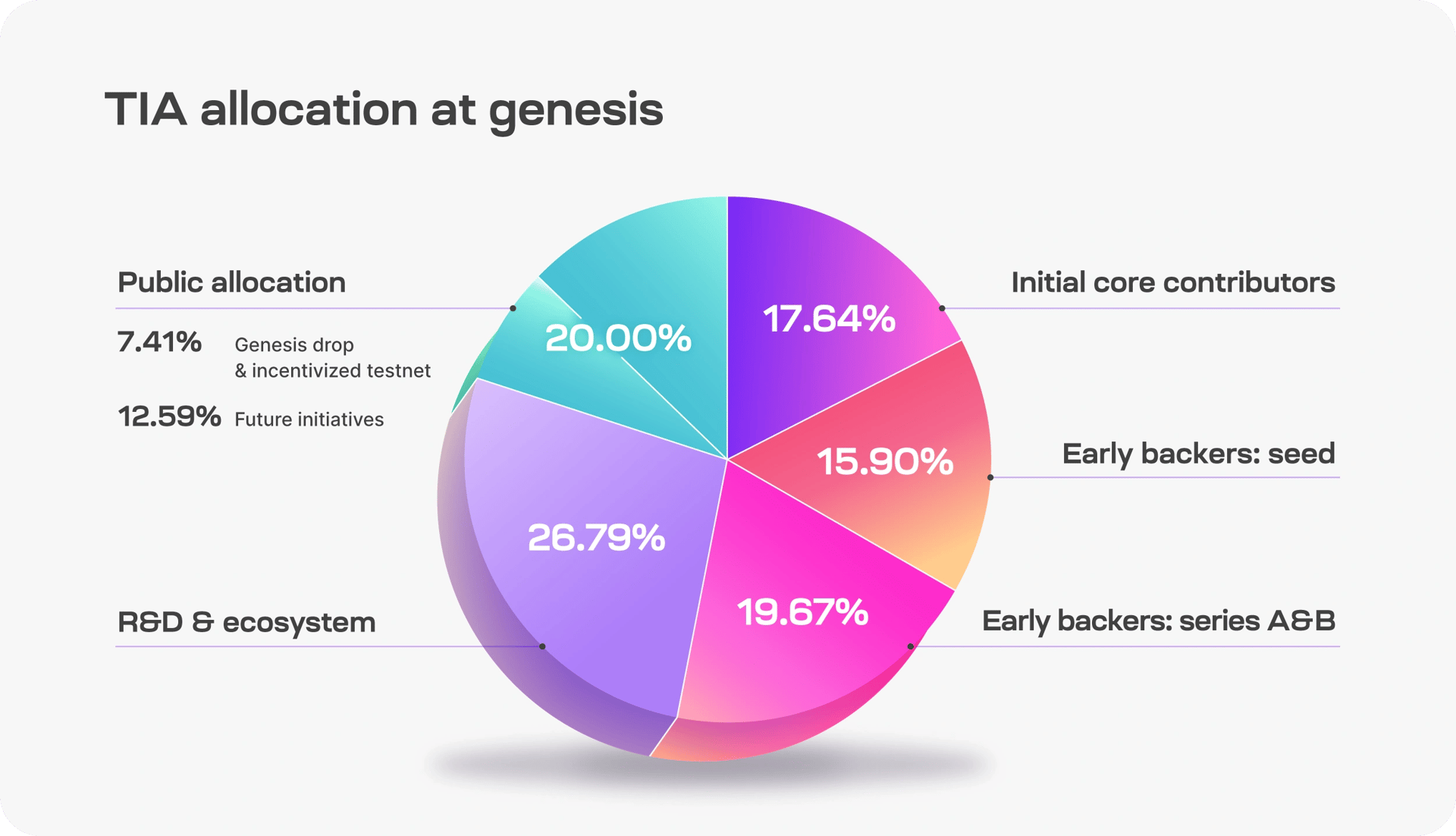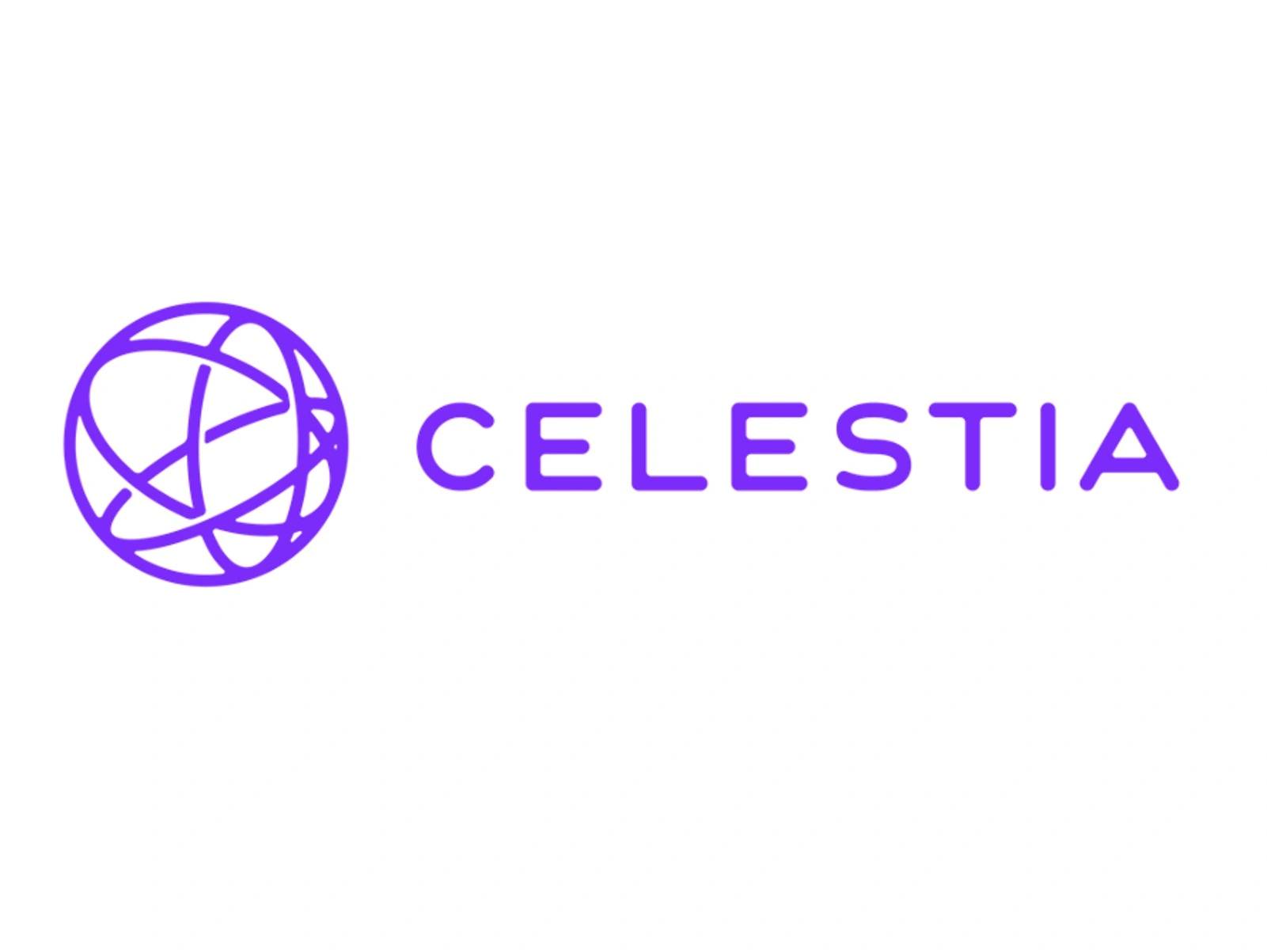订阅 wiki
Share wiki
Bookmark
Celestia
Celestia
Celestia 是一个模块化数据可用性网络,旨在随着用户数量的增加而安全地扩展,从而可以轻松部署个性化的区块链。它通过将执行与共识分离,并引入一种名为数据可用性采样的新元素,来促进可扩展的区块链架构的创建,特别是模块化区块链。Mustafa Al-Bassam 和 Ismail Khoffi 创立了 Celestia。 [1] [2]
概述
Celestia 是一个模块化数据可用性网络,它将共识与执行分离,以提高可扩展性和灵活性。它专注于交易排序和确保数据可用性,允许其他区块链独立处理执行。通过使用数据可用性采样,Celestia 使轻量级节点能够通过仅检查一小部分数据来验证数据,从而降低资源需求。随着更多节点加入并执行采样,网络可以处理更大的区块,而无需增加验证成本,从而支持模块化区块链的增长。 [2] [11]
历史
Celestia起源于Mustafa Al-Bassam 2019年的白皮书,名为LazyLedger,该白皮书提出了一种仅关注数据可用性而不处理计算或执行的账本。为了将这个想法发展成一个项目,Al-Bassam组建了一个团队,其中包括联合创始人Ismail Khoffi(Cosmos生态系统开发者)和John Adler(在乐观rollup技术方面经验丰富)。该项目于2021年更名为Celestia,其主网于2023年10月31日启动。
启动后,Celestia获得了Bain Capital Crypto、Coinbase Ventures和Jump Crypto等主要加密公司的支持。其原生代币TIA大幅增长,到2023年12月中旬增长了500%。该项目与Polygon Labs和Optimism Labs合作,将Celestia的数据可用性层集成到他们的rollup解决方案中。2024年2月,Celestia还为Arbitrum Orbit协议做出了贡献,使开发人员能够将Celestia与Arbitrum AnyTrust一起用于rollup数据可用性。 [12]
数据可用性层 (DA)
Celestia 的数据可用性 (DA) 层允许执行和结算层独立验证交易数据是否可访问,而无需依赖中心化信任。它通过将数据可用性与执行分离,引入了一种模块化方法,从而实现更具可扩展性的 区块链 结构。这通过两个关键特性实现:数据可用性采样 (DAS),允许轻节点通过检查小数据样本而不是完整区块来确认数据可用性;以及命名空间 Merkle Trees (NMT),将数据组织成命名空间,以便应用程序可以仅检索与其相关的部分。
DA 层作为 权益证明 区块链 运行,称为 celestia-app,使用 Cosmos SDK 构建。它运行在 Celestia-core 上,这是 Tendermint 共识协议的定制版本。修改包括支持二维 Reed-Solomon 纠删码和 NMT,替换 Tendermint 的默认 Merkle tree 以实现选择性数据访问。Celestia-core 通过 ABCI++ 连接到应用层,ABCI++ 是 区块链 应用程序的升级接口。Celestia 应用程序管理 质押 和治理,但不处理或存储 区块 数据。它有助于分发数据,保持数据不可知的角色。 [4]
数据可用性采样 (DAS)
Celestia 使用数据可用性采样 (DAS) 允许轻节点验证区块数据,而无需下载整个数据集。为了实现这一点,Celestia 应用了一种二维 Reed-Solomon 编码方法。区块数据首先被分成一个 k×k 的数据块矩阵,然后使用通过多次编码应用生成的奇偶校验数据扩展成一个 2k×2k 的矩阵。为每行和每列计算 Merkle 根(总共 4k 个),这些根的 Merkle 根成为区块头中的数据承诺。 [4]
可扩展性
DAS通过使资源有限的轻节点仅采样一小部分区块数据来提高可扩展性。随着更多轻节点的参与,下载和存储数据的总容量增加。这种方法允许网络支持更大的区块,而不会给单个节点带来过重的负担。然而,Celestia轻节点仍然必须下载4k个中间Merkle根来验证区块头。对于大小为n²字节的区块数据,每个轻节点下载O(n)字节,这意味着轻节点带宽的改进会导致数据可用性层吞吐量的二次方增加。 [4]
错误扩展数据的欺诈证明
Celestia 使用二维里德-所罗门编码,相比标准的一维编码具有优势。在标准方法中,数据被分成 k 块,并用 k 个奇偶校验块进行扩展,对这 2k 块进行 Merkle 根承诺。这种方法减少了验证数据的大小,但更容易受到区块生产者引入无效扩展数据的影响。如果发生这种情况,即使轻节点收集了足够多的唯一样本,也可能无法恢复原始数据。
Celestia 使用欺诈证明来缓解这种风险,欺诈证明允许轻节点检测并拒绝包含不正确扩展数据的区块。这些证明涉及重建和验证编码数据的部分。虽然标准方法需要下载完整的 n² 字节数据进行验证,但二维方法只需要 O(n) 字节,因为验证矩阵的单行或单列就足以检测到不一致之处。 [4]
命名空间默克尔树 (NMTs)
命名空间 默克尔树 (NMTs) 在 Celestia 中用于按应用程序或命名空间组织区块数据。每个应用程序,例如 rollup,都被分配其命名空间,允许它仅下载与其相关的数据并忽略无关信息。NMTs 通过根据其命名空间标识符对叶子进行排序并更改哈希函数来修改标准 默克尔树,以便每个节点都包含其后代的命名空间范围。这种结构允许应用程序验证其数据的包含性和完整性。当请求特定命名空间的数据时,DA 层必须提供相关的数据份额和证明节点。如果数据不完整,应用程序可以通过检查证明 节点 中的命名空间范围来检测到这一点。 [4]
Celestia 模块化聚会计划
Celestia 模块化聚会计划旨在通过提供教育和支持来协助聚会组织者,从而促进 Web3 生态系统内的协作。
组织者将获得支持,包括示例研讨会、场地保障指导和营销协助。他们还可以访问演讲者名单,从而邀请 Celestia Labs 和模块化生态系统的演讲者参加他们的聚会,无论是面对面还是虚拟的。 [5] [6]
模块化研究员
模块化研究员计划旨在帮助模块化构建者开发可扩展和自主的区块链网络。在为期三个月的计划中,参与者将获得工程支持、指导以及每月3,000美元的津贴,用于从事他们选择的项目。计划结束后,将为研究员提供持续的支持,包括筹款方面的帮助以及获得赠款的机会。
参与者每月完成一个项目里程碑,最后在演示日进行演示。通过每周的办公时间、课程和教程、参与者演示、沟通以及每月津贴提供支持。导师包括魏戴、坎·古雷尔、埃里克·沃尔、伊莱·克伦茨克、扎基·马尼安、马尔科·巴里切维奇、摩根·贝勒、约翰·阿德勒、穆斯塔法·阿尔-巴萨姆、伊斯梅尔·霍菲和埃文·福布斯。 [7]
模块化峰会
模块化峰会是由 Celestia Labs 主办的为期两天的活动,旨在让建设者了解模块化区块链。2023 年的峰会于 7 月 21 日至 22 日在巴黎举行。演讲者包括 Mustafa AI-Bassam、Sandeep Nailwal、Vitalik Buterin、Chris Goes、Georgios Konstantopoulos 和 Tina Zhen。 [8]
Celestia Foundation
Celestia基金会是一个位于列支敦士登的非营利组织,其宗旨是为Celestia生态系统提供指导并维护其价值观。基金会理事会管理Celestia基金会。 [9]
融资
Celestia的A轮和B轮融资于2022年10月进行。该项目由Bain Capital Crypto和Polychain Capital领投,筹集了5500万美元,估值达到10亿美元。值得注意的融资参与者包括Coinbase Ventures、Delphi Digital、Placeholder、Jump Crypto和Galaxy等。 [10]
TIA
TIA代币是Celestia的原生加密货币,主要用于交易费用和治理参与。它的初始供应量为10亿个代币,其中7%通过空投分发给早期用户。该代币是通货膨胀型的,每年供应量增加约8%,但计划随着时间的推移而降低这个比率。
TIA在Celestia的权益证明网络中运作,允许持有者质押代币以支持网络安全和治理。开发者使用TIA来支付数据可用性服务,并作为部署基于Celestia的rollup时的gas费用。 [12] [13]
代币经济学

TIA 的总供应量为 10 亿枚代币,分配如下:[14]
- 研发/生态系统: 26.79%
- 公开分配: 20%
- A轮和B轮早期支持者: 19.67%
- 初始核心贡献者: 17.64%
- 种子轮早期支持者: 15.90%
发现错误了吗?
